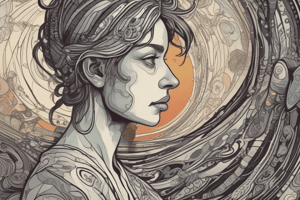Podcast
Questions and Answers
What are the two main categories of symptoms of schizophrenia?
What are the two main categories of symptoms of schizophrenia?
- Emotional and physical symptoms
- Social and psychological symptoms
- Cognitive and behavioral symptoms
- Positive and negative symptoms (correct)
What is a key biological correlate in the etiology of major depressive disorder?
What is a key biological correlate in the etiology of major depressive disorder?
- Hyperactivity of the HPA axis (correct)
- Enlarged brain ventricles
- Increased serotonin levels
- Excess dopamine activity
Which of the following personality traits is associated with the concept of neuroticism?
Which of the following personality traits is associated with the concept of neuroticism?
- Emotional instability and anxiety (correct)
- Sociability and enthusiasm
- Organization and dependability
- Empathy and cooperation
What type of assessment method is the Rorschach Inkblot Test classified as?
What type of assessment method is the Rorschach Inkblot Test classified as?
Which is a common symptom of bipolar disorder associated with Bipolar I?
Which is a common symptom of bipolar disorder associated with Bipolar I?
What is a significant sociocultural influence observed in major depressive disorder?
What is a significant sociocultural influence observed in major depressive disorder?
Which of the following is NOT a symptom of schizophrenia?
Which of the following is NOT a symptom of schizophrenia?
Which test is designed to assess the Big Five personality traits?
Which test is designed to assess the Big Five personality traits?
What is a common characteristic that classifies schizophrenia symptoms as negative?
What is a common characteristic that classifies schizophrenia symptoms as negative?
Which neurotransmitter's dysfunction is primarily associated with the cognitive deficits observed in schizophrenia?
Which neurotransmitter's dysfunction is primarily associated with the cognitive deficits observed in schizophrenia?
What is the minimum duration of symptoms for diagnosing major depressive disorder?
What is the minimum duration of symptoms for diagnosing major depressive disorder?
Which of the following best describes the difference between Bipolar I and Bipolar II disorders?
Which of the following best describes the difference between Bipolar I and Bipolar II disorders?
What psychological factor is associated with a greater risk of major depressive disorder?
What psychological factor is associated with a greater risk of major depressive disorder?
Which personality trait is characterized by emotional instability and anxiety?
Which personality trait is characterized by emotional instability and anxiety?
In cultural considerations for psychological disorders, what is a critical factor that helps avoid misdiagnoses?
In cultural considerations for psychological disorders, what is a critical factor that helps avoid misdiagnoses?
Which of the following assessment methods primarily uses ambiguous stimuli to reveal unconscious processes?
Which of the following assessment methods primarily uses ambiguous stimuli to reveal unconscious processes?
Flashcards
Schizophrenia Symptoms
Schizophrenia Symptoms
Positive symptoms include hallucinations, delusions, and disorganized behavior, while negative symptoms involve reduced emotional expression and motivation. Cognitive deficits impact attention, memory, and executive function.
Schizophrenia Etiology
Schizophrenia Etiology
Schizophrenia is linked to a combination of genetic predisposition, neurochemical imbalances (like dopamine), and neuroanatomical differences (like enlarged ventricles).
Major Depressive Disorder Symptoms
Major Depressive Disorder Symptoms
Persistent depressed mood, loss of interest in activities (anhedonia), and lasting for at least two weeks.
Mood Disorders Biological Factors
Mood Disorders Biological Factors
Signup and view all the flashcards
DSM-5-TR Diagnosis
DSM-5-TR Diagnosis
Signup and view all the flashcards
Schizophrenia Prevalence
Schizophrenia Prevalence
Signup and view all the flashcards
Bipolar Disorder Types
Bipolar Disorder Types
Signup and view all the flashcards
Mood Disorders Psychological Factors
Mood Disorders Psychological Factors
Signup and view all the flashcards
What are Psychological Disorders?
What are Psychological Disorders?
Signup and view all the flashcards
DSM-5-TR Diagnosis Criteria
DSM-5-TR Diagnosis Criteria
Signup and view all the flashcards
Schizophrenia Positive Symptoms
Schizophrenia Positive Symptoms
Signup and view all the flashcards
Schizophrenia Negative Symptoms
Schizophrenia Negative Symptoms
Signup and view all the flashcards
Major Depressive Disorder
Major Depressive Disorder
Signup and view all the flashcards
Personality Traits and Mental Health
Personality Traits and Mental Health
Signup and view all the flashcards
Study Notes
Psychological Disorders
- Mental disorders involve patterns of behavior, thought, or emotion that are significantly deviant, distressing, and dysfunctional.
- Diagnoses require clinically significant distress or impairment. Cultural context is crucial to avoid misdiagnosis. Culturally bound syndromes exist (e.g., ataque de nervios in Latin cultures).
Schizophrenia
- Symptoms:
- Positive: Hallucinations (e.g., auditory voices), delusions (e.g., persecutory or grandiose beliefs), disorganized speech and behavior.
- Negative: Affective flattening (diminished emotional expression), anhedonia (loss of pleasure), social withdrawal.
- Cognitive Deficits: Impaired attention, memory, and executive functioning.
- Etiology:
- Genetic Predisposition: High concordance rates in identical twins (~50%).
- Neurochemical: Excess dopamine activity in mesolimbic pathways, reduced dopamine in prefrontal regions.
- Neuroanatomical: Enlarged ventricles, hypofrontality (reduced frontal lobe activity).
- Prevalence: Affects approximately 1% of the population, typically appearing in late adolescence or early adulthood.
Mood Disorders
- Major Depressive Disorder:
- Symptoms must last at least two weeks, including depressed mood and anhedonia.
- Biological Correlates: Low serotonin, norepinephrine, and dopamine levels; hyperactivity of the HPA axis leading to elevated cortisol.
- Psychological Factors: Negative attributional style, learned helplessness.
- Sociocultural Influences: Higher prevalence in women, potentially due to social roles and hormonal differences.
- Bipolar Disorder:
- Bipolar I: Full manic episodes.
- Bipolar II: Hypomanic episodes with depressive episodes.
Assessment Methods
- Objective Tests:
- MMPI: Measures psychopathology and personality traits.
- NEO Personality Inventory: Assesses the Big Five personality traits.
- Projective Tests:
- Rorschach Inkblot Test: Interprets responses to ambiguous stimuli to uncover unconscious processes.
- Thematic Apperception Test (TAT): Examines narratives created about ambiguous images to infer motives, conflicts, and personality dynamics.
Cultural and Environmental Influences
- Individualism vs. Collectivism:
- Individualistic cultures prioritize independence and self-expression.
- Collectivist cultures emphasize group harmony and interconnectedness.
- Reciprocal Determinism (Bandura): Personality is shaped by interactions between behavior, cognitive factors, and environmental influences.
Studying That Suits You
Use AI to generate personalized quizzes and flashcards to suit your learning preferences.




